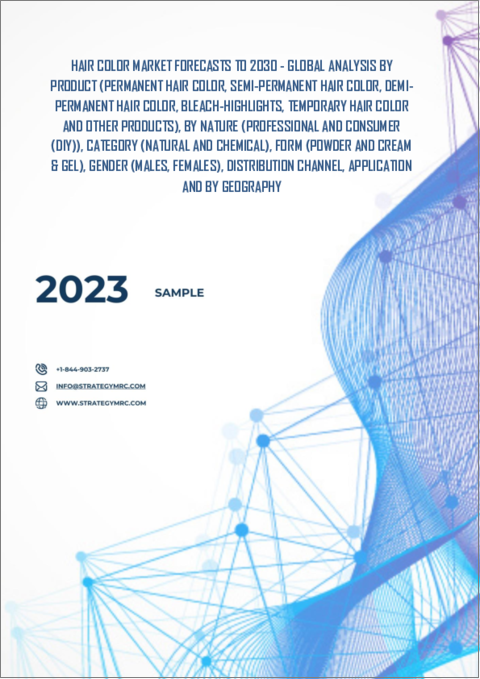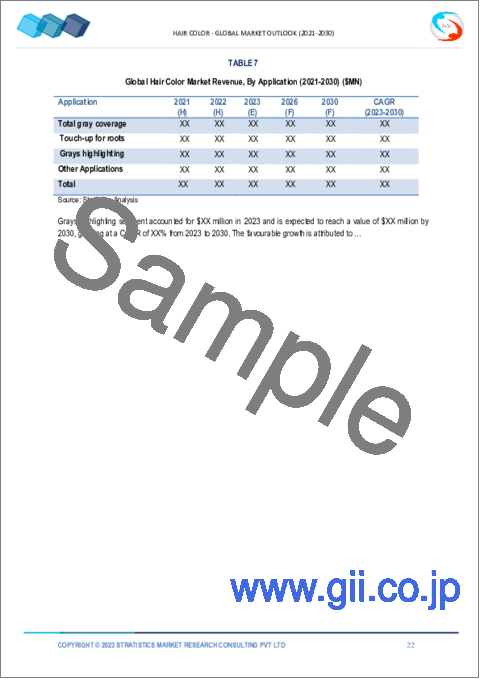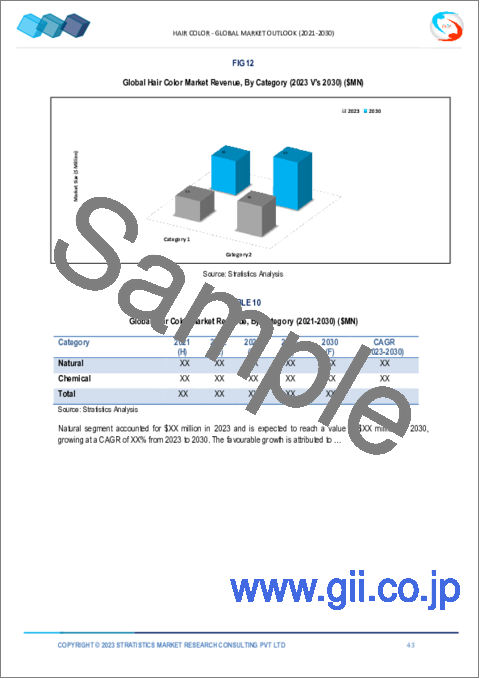|
|
市場調査レポート
商品コード
1383410
ヘアカラー市場の2030年までの予測:製品別、性質別、カテゴリー別、形態別、性別、流通チャネル別、用途別、地域別の世界分析Hair Color Market Forecasts to 2030 - Global Analysis By Product, By Nature (Professional and Consumer ), Category, Form, Gender, Distribution Channel, Application and By Geography |
||||||
カスタマイズ可能
|
|||||||
| ヘアカラー市場の2030年までの予測:製品別、性質別、カテゴリー別、形態別、性別、流通チャネル別、用途別、地域別の世界分析 |
|
出版日: 2023年11月01日
発行: Stratistics Market Research Consulting
ページ情報: 英文 200+ Pages
納期: 2~3営業日
|
- 全表示
- 概要
- 図表
- 目次
Stratistics MRCによると、世界のヘアカラー市場は2023年に272億米ドルを占め、予測期間中にCAGR 9.8%で成長し、2030年には523億米ドルに達すると予想されています。
ヘアカラーは、染毛剤としても知られ、様々な化学物質や天然物質を用いて髪の自然な色を変えることを指します。ヘアカラーは一般的に、白髪を隠したり、異なる美的外観を実現したり、単に個人的なスタイルを表現したりといった美容目的で使用されます。
中華人民共和国財政部によると、2021年の中国の衛生・パーソナルケアおよび医療に対する公的支出総額は1兆9,200億人民元(2,956億8,000万米ドル)と推定されています。
進化するファッションと美容の動向
セレブリティは世間の認識や動向に大きな影響力を持ち、彼らのヘアカラー選択はしばしばスタイルの新しい基準を打ち立てる。有名人が特定のヘアカラー・ブランドを支持したり、象徴的なカラー・チェンジを誇示したりすることは、強力なマーケティング・ツールを生み出します。消費者は、お気に入りのスターのルックスを模倣しようと、これらの製品を受け入れる可能性が高くなります。その結果、ヘアカラー企業は、こうした支持や象徴的な変身を活用して消費者ベースを拡大し、製品の売上を伸ばすことができます。セレブリティとヘアカラー・ブランドとのコラボレーションは、相互に利益をもたらす戦略であり、市場の成長可能性をさらに高めることができます。
化学物質過敏症とアレルギー
従来のヘアカラー製品の多くには、アンモニアやパラフェニレンジアミン(PPD)といった化学物質が含まれており、軽度の皮膚刺激から重度の皮膚科学的問題に至るまで、アレルギー反応や過敏症を引き起こす可能性があります。このような懸念から、消費者の警戒心が高まり、より優しく、低刺激性の代替ヘアカラーへの需要が高まっています。メーカーは現在、鮮やかで長持ちするカラーを提供しながら、副作用のリスクを最小限に抑える処方を開発する必要に迫られています。厳しい安全基準を遵守し、潜在的なアレルゲンを明確に表示することは、このような制約を緩和し、ヘアカラー業界に対する消費者の信頼を維持するために極めて重要なステップです。
有名人の支持と象徴的なヘアカラーの変化
消費者のライフスタイルが変化し、便利ですぐに食べられる食事への嗜好が高まる中、製品の鮮度と品質を長期間維持できる包装ソリューションへのニーズが高まっています。高度なバリア特性と密封技術を備えたヘアカラーは、腐敗、微生物汚染、酸化を防ぐことで保存期間を効果的に延長します。これは、便利でありながら安全な食品を求める消費者の要望に応えるものであり、食品廃棄を最小限に抑えるという業界の動向とも一致します。その結果、ヘアカラーの採用は、製品の保存期間を延ばすという重要な要件を満たす能力によって促進されています。
進化する規制と特定成分への制限
政府や規制機関がヘアカラーを含む化粧品の安全性や成分に関して厳しくなるにつれ、メーカーはコンプライアンス要件への適応という課題に直面しています。成分規制は、製品の有効性や性能に影響を及ぼす可能性のある、これまで使用されていた成分の再製造や除去につながる可能性があります。その結果、生産コストが増加し、大規模な安全性試験が必要になることもあります。さらに、世界的に異なる規制を遵守することは、国際貿易や製品の入手を複雑にする可能性があります。メーカーは、変化する規制に合わせて配合を継続的に監視・調整しなければならず、これは製品の革新や消費者の選択に影響を与える可能性があり、業界にとって重大な課題となっています。
COVID-19の影響:
COVID-19の大流行はヘアカラー市場に多面的な影響を与えました。当初、ロックダウンや社会的距離を置く措置によってサロンへの来店が減り、一部の消費者は家庭でのヘアカラーに目を向けるようになっています。しかし、景気の先行き不透明感や家に閉じこもるライフスタイルの影響もあり、多くの消費者がヘアカラーを含む美容製品への支出を抑えました。サプライチェーンの混乱や製造上の課題は、製品の入手性に影響を与え、一時的な品不足を引き起こしました。さらに、サロン来店時の安全性への懸念や、一部のサロンの閉鎖は、プロによるカラーサービスに影響を与えました。家庭用カラーキットは人気を博したが、市場全体は変動しました。流行が進化するにつれ、ヘアカラー市場における消費者の嗜好や購買習慣は適応し続けています。
予測期間中、一時的なヘアカラー分野が最大となる見込み
一時的なヘアカラー分野は有利な成長が見込まれます。永久的なヘアカラーとは異なり、一時的なヘアカラー製品は毛髪軸に深く浸透しないため、長期間のコミットメントなしにカラーチェンジが可能です。これらの製品は、スプレー、ジェル、シャンプー、リンスなど様々な形態で販売されています。永久的なヘアカラーに伴う潜在的なダメージなしに、さまざまな色合い、ハイライト、鮮やかな色を素早く簡単に試すことができます。一時的なヘアカラーは、特別な日やお祭り、季節の動向に特に人気があります。個人のスタイルや創造性を表現するためのダイナミックでリスクの少ない選択肢を提供するため、従来の毛染めのような永久性を必要とせず、柔軟性と一時的な変身を求める幅広い消費者層に魅力的です。
スーパーマーケット/ハイパーマーケット分野は予測期間中最も高いCAGRが見込まれる
スーパーマーケット/ハイパーマーケット分野は、予測期間中に最も速いCAGRの成長が見込まれます。これらの店舗では、ブランド、色合い、処方の幅広い品揃えを提供しているため、消費者は日常的な買い物のついでにヘアカラー製品を見たり購入したりすることができ、便利です。店内では、知識豊富なスタッフや魅力的なディスプレイが用意されていることが多く、消費者が十分な情報を得た上で選択するのに役立っています。さらに、都市部や郊外では、スーパーマーケットやハイパーマーケットを利用しやすいため、製品を幅広く入手することができます。これらの小売店は、手頃な価格の家庭用ヘアカラー・ソリューションやサロン品質のプロ用製品を求める消費者など、多様な顧客層に対応しており、ヘアカラー市場の広範な普及と消費者の利用しやすさに貢献しています。
最大のシェアを占める地域:
予測期間中、欧州市場が引き続き市場シェアの大半を占めると予想されます。この地域は多様で流行に敏感な消費者層を誇り、ヘアカラー製品に対する安定した需要を牽引しています。欧州の消費者は、環境意識の高まりを反映し、ナチュラルやオーガニックの選択肢を含むヘアカラーのイノベーションに強い親近感を抱いています。欧州市場の特徴は、プロフェッショナルなサロンサービスと家庭でのカラーリングソリューションが融合していることで、ダイナミックで多面的な産業となっています。さらに、厳しい規制基準と製品の安全性に対する意識の高まりが、高品質で安全なヘアカラー処方の開発に寄与しています。美容とファッションの豊かな歴史を持つ欧州は、ヘアカラーの動向、研究、製品開発の重要な拠点であり続けています。
CAGRが最も高い地域:
アジア太平洋は、予測期間中に最も高いCAGRを示すと予測されます。人口が多く多様性に富むこの地域では、都市化、可処分所得の増加、美意識の高い消費者層の増加といった要因によって、ヘアカラー製品に対する需要が増加しています。同市場は、伝統的な嗜好と、トレンディで鮮やかな色合いのヘアカラーへの憧れが混在していることを反映しています。さらに、天然素材やハーブを使ったヘアカラーが人気であることは、この地域がウェルネスと持続可能性に重点を置いていることと一致しています。その結果、アジア太平洋は、既存ブランドと新興ブランドの両方にとって、製品を拡大し、消費者の多様でダイナミックな嗜好に対応するための肥沃な土壌となっています。
無料カスタマイズサービス:
本レポートをご購読のお客様には、以下の無料カスタマイズオプションのいずれかをご利用いただけます:
- 企業プロファイル
- 追加市場参入企業の包括的プロファイリング(3社まで)
- 主要企業のSWOT分析(3社まで)
- 地域セグメンテーション
- 顧客の関心に応じた主要国の市場推定・予測・CAGR(注:フィージビリティチェックによる)
- 競合ベンチマーキング
- 製品ポートフォリオ、地理的プレゼンス、戦略的提携に基づく主要企業のベンチマーキング
目次
第1章 エグゼクティブサマリー
第2章 序文
- 概要
- ステークホルダー
- 調査範囲
- 調査手法
- データ鉱業
- データ分析
- データ検証
- 調査アプローチ
- 調査ソース
- 1次調査ソース
- 2次調査ソース
- 前提条件
第3章 市場動向分析
- イントロダクション
- 促進要因
- 抑制要因
- 機会
- 脅威
- 製品分析
- 用途分析
- 新興市場
- 新型コロナウイルス感染症(COVID-19)の影響
第4章 ポーターのファイブフォース分析
- 供給企業の交渉力
- 買い手の交渉力
- 代替品の脅威
- 新規参入業者の脅威
- 競争企業間の敵対関係
第5章 世界のヘアカラー市場:製品別
- イントロダクション
- 永久的なヘアカラー
- 半永久的なヘアカラー
- デミパーマネントヘアカラー
- ブリーチハイライト
- 一時的なヘアカラー
- その他の製品
第6章 世界のヘアカラー市場:性質別
- イントロダクション
- プロ
- 消費者(DIY)
第7章 世界のヘアカラー市場:カテゴリー別
- イントロダクション
- 自然
- 化学薬品
第8章 世界のヘアカラー市場:形態別
- イントロダクション
- 粉末
- クリーム&ジェル
第9章 世界のヘアカラー市場:性別
- イントロダクション
- 男性
- 女性
第10章 世界のヘアカラー市場:流通チャネル別
- イントロダクション
- スーパーマーケット/ハイパーマーケット
- コンビニ/食料品店
- 健康と美容の専門小売店
- オンライン小売店
- その他の流通チャネル
第11章 世界のヘアカラー市場:用途別
- イントロダクション
- トータルグレーカバレッジ
- 根元タッチアップ
- グレーハイライト
- その他の用途
第12章 世界のヘアカラー市場:地域別
- イントロダクション
- 北米
- 米国
- カナダ
- メキシコ
- 欧州
- ドイツ
- 英国
- イタリア
- フランス
- スペイン
- その他の欧州
- アジア太平洋
- 日本
- 中国
- インド
- オーストラリア
- ニュージーランド
- 韓国
- その他のアジア太平洋
- 南米
- アルゼンチン
- ブラジル
- チリ
- その他の南米
- 中東およびアフリカ
- サウジアラビア
- アラブ首長国連邦
- カタール
- 南アフリカ
- その他の中東およびアフリカ
第13章 主な発展
- 契約、パートナーシップ、コラボレーション、合弁事業
- 買収と合併
- 新製品の発売
- 事業拡大
- その他の主要戦略
第14章 企業プロファイル
- Coty Inc.
- Godrej Consumer Products Limited,
- Estee Lauder
- Henkel AG & Co. KGaA
- Arctic Fox
- Aroma
- Avon Products
- Cadiveu Professional USA
- L'Oreal S.A,
- Combe Incorporated
- PZ Cussons Beauty LLP
- Conair
- Hygienic Research Institute Pvt. Ltd.(Brand-Streax)
- Johnson & Johnson
- Kao Corporation
- Revlon
List of Tables
- Table 1 Global Hair Color Market Outlook, By Region (2021-2030) ($MN)
- Table 2 Global Hair Color Market Outlook, By Product (2021-2030) ($MN)
- Table 3 Global Hair Color Market Outlook, By Permanent Hair Color (2021-2030) ($MN)
- Table 4 Global Hair Color Market Outlook, By Semi-permanent Hair Color (2021-2030) ($MN)
- Table 5 Global Hair Color Market Outlook, By Demi-permanent Hair Color (2021-2030) ($MN)
- Table 6 Global Hair Color Market Outlook, By Bleach-highlights (2021-2030) ($MN)
- Table 7 Global Hair Color Market Outlook, By Temporary Hair Color (2021-2030) ($MN)
- Table 8 Global Hair Color Market Outlook, By Other Products (2021-2030) ($MN)
- Table 9 Global Hair Color Market Outlook, By Nature (2021-2030) ($MN)
- Table 10 Global Hair Color Market Outlook, By Professional (2021-2030) ($MN)
- Table 11 Global Hair Color Market Outlook, By Consumer (DIY) (2021-2030) ($MN)
- Table 12 Global Hair Color Market Outlook, By Category (2021-2030) ($MN)
- Table 13 Global Hair Color Market Outlook, By Natural (2021-2030) ($MN)
- Table 14 Global Hair Color Market Outlook, By Chemical (2021-2030) ($MN)
- Table 15 Global Hair Color Market Outlook, By Form (2021-2030) ($MN)
- Table 16 Global Hair Color Market Outlook, By Powder (2021-2030) ($MN)
- Table 17 Global Hair Color Market Outlook, By Cream & Gel (2021-2030) ($MN)
- Table 18 Global Hair Color Market Outlook, By Gender (2021-2030) ($MN)
- Table 19 Global Hair Color Market Outlook, By Males (2021-2030) ($MN)
- Table 20 Global Hair Color Market Outlook, By Females (2021-2030) ($MN)
- Table 21 Global Hair Color Market Outlook, By Distribution Channel (2021-2030) ($MN)
- Table 22 Global Hair Color Market Outlook, By Supermarkets/Hypermarkets (2021-2030) ($MN)
- Table 23 Global Hair Color Market Outlook, By Convenience/Grocery Stores (2021-2030) ($MN)
- Table 24 Global Hair Color Market Outlook, By Health and Beauty Specialist Retailers (2021-2030) ($MN)
- Table 25 Global Hair Color Market Outlook, By Online Retail Stores (2021-2030) ($MN)
- Table 26 Global Hair Color Market Outlook, By Other Distribution Channels (2021-2030) ($MN)
- Table 27 Global Hair Color Market Outlook, By Application (2021-2030) ($MN)
- Table 28 Global Hair Color Market Outlook, By Total gray coverage (2021-2030) ($MN)
- Table 29 Global Hair Color Market Outlook, By Touch-up for roots (2021-2030) ($MN)
- Table 30 Global Hair Color Market Outlook, By Grays highlighting (2021-2030) ($MN)
- Table 31 Global Hair Color Market Outlook, By Other Applications (2021-2030) ($MN)
Note: Tables for North America, Europe, APAC, South America, and Middle East & Africa Regions are also represented in the same manner as above.
According to Stratistics MRC, the Global Hair Color Market is accounted for $27.2 billion in 2023 and is expected to reach $52.3 billion by 2030 growing at a CAGR of 9.8% during the forecast period. Hair color, also known as hair dye or hair coloring, refers to the practice of changing the natural color of one's hair using various chemical or natural substances. Hair color is commonly used for cosmetic purposes, such as covering gray hair, achieving a different aesthetic look, or simply expressing one's personal style.
According to the Ministry of Finance of the People's Republic of China, the total public spending on hygiene/personal care and health care in 2021 for China was estimated to be CNY 1.92 trillion (USD 295.68 billion).
Market Dynamics:
Driver:
Evolving fashion and beauty trends
Celebrities wield considerable influence over public perception and trends, and their hair color choices often set new standards for style. When celebrities endorse specific hair color brands or flaunt iconic color changes, it creates a powerful marketing tool. Consumers are more likely to embrace these products, seeking to emulate their favorite stars' looks. As a result, hair color companies can leverage these endorsements and iconic transformations to expand their consumer base and boost product sales. The collaboration between celebrities and hair color brands can be a mutually beneficial strategy, further enhancing the market's growth potential.
Restraint:
Chemical sensitivities and allergies
Many traditional hair color products contain chemicals like ammonia and paraphenylenediamine (PPD) that can trigger allergic reactions and sensitivities, ranging from mild skin irritation to severe dermatological issues. This concern has led to increased consumer wariness and a demand for gentler, hypoallergenic hair color alternatives. Manufacturers are now under pressure to develop formulations that minimize the risk of adverse reactions while delivering vibrant and long-lasting color. Adhering to stringent safety standards and providing clear labeling of potential allergens are crucial steps to alleviate this restraint and maintain consumer trust in the hair color industry.
Opportunity:
Celebrity endorsements and iconic hair color changes
With changing consumer lifestyles and preferences for convenient, ready-to-eat meals, there's a growing need for packaging solutions that can maintain product freshness and quality over longer periods of time. Hair Color, equipped with advanced barrier properties and sealing technologies, effectively extend shelf life by preventing spoilage, microbial contamination, and oxidation. This addresses the consumer's desire for convenient yet safe food options and aligns with industry trends towards minimizing food waste. As a result, the adoption of Hair Color is fueled by their ability to meet the crucial requirement of prolonged product shelf life.
Threat:
Evolving regulations and restrictions on certain ingredients
As governments and regulatory bodies become more stringent regarding the safety and composition of cosmetic products, including hair color, manufacturers face challenges in adapting to compliance requirements. Ingredient restrictions can lead to reformulations or the removal of previously used components, potentially affecting product effectiveness and performance. This can result in increased production costs and the need for extensive safety testing. Additionally, compliance with varying global regulations can complicate international trade and product availability. Manufacturers must continually monitor and adjust their formulations to align with changing regulations, which can impact product innovation and consumer choices, posing a significant challenge to the industry.
COVID-19 Impact:
The COVID-19 pandemic had a multifaceted impact on the hair color market. Initially, lockdowns and social distancing measures led to reduced salon visits, prompting some consumers to turn to at-home hair coloring solutions. However, the economic uncertainty and stay-at-home lifestyle also caused many to reduce discretionary spending on beauty products, including hair color. Supply chain disruptions and manufacturing challenges affected product availability and caused temporary shortages. Additionally, safety concerns during salon visits and the closure of some salons impacted professional color services. While at-home color kits gained popularity, the overall market saw fluctuations. As the pandemic evolves, consumer preferences and purchasing habits in the hair color market continue to adapt.
The temporary hair color segment is expected to be the largest during the forecast period
The temporary hair color segment is expected to have a lucrative growth. Unlike permanent hair dyes, temporary hair color products do not penetrate the hair shaft deeply, allowing for color change without long-lasting commitment. These products are available in various forms, including sprays, gels, shampoos, and rinses. They offer a quick and easy way to experiment with different shades, highlights, or vibrant colors without the potential damage associated with permanent dyes. Temporary hair color is particularly popular for special occasions, festivals, or seasonal trends. It provides a dynamic and low-risk option for individuals to express their style and creativity, making it appealing to a broad consumer base seeking flexibility and temporary transformations without the permanence of traditional hair dyes.
The supermarkets/hypermarkets segment is expected to have the highest CAGR during the forecast period
The supermarkets/hypermarkets segment is anticipated to witness the fastest CAGR growth during the forecast period. These stores offer a wide selection of brands, shades, and formulations, making it convenient for consumers to browse and purchase hair color products during their routine shopping trips. The in-store experience often includes knowledgeable staff and attractive displays that help consumers make informed choices. Additionally, the accessibility of supermarkets and hypermarkets in urban and suburban areas ensures broad product availability. These retail outlets cater to a diverse customer base, including those seeking affordable at-home hair color solutions and professional salon-quality products, contributing to the hair color market's widespread reach and consumer accessibility.
Region with largest share:
During the forecast period, it is expected that the Europe market will continue to hold a majority of the market share. This region boasts a diverse and fashion-conscious consumer base, driving consistent demand for hair color products. Consumers in Europe have a strong affinity for hair color innovations, including natural and organic options, reflecting the growing trend of eco-consciousness. The European market is characterized by a blend of professional salon services and at-home colouring solutions, making it a dynamic and multifaceted industry. Moreover, stringent regulatory standards and increasing awareness of product safety contribute to the development of high-quality and safe hair color formulations. With a rich history of beauty and fashion, Europe continues to be a significant hub for hair color trends, research, and product development.
Region with highest CAGR:
Asia Pacific is projected to have the highest CAGR over the forecast period. With a large and diverse population, this region experiences increasing demand for hair color products, driven by factors such as urbanization, rising disposable incomes, and a growing beauty-conscious consumer base. The market reflects a blend of traditional preferences and an appetite for trendy and vibrant hair color shades. Moreover, the popularity of natural and herbal hair color alternatives aligns with the region's focus on wellness and sustainability. As a result, Asia Pacific presents a fertile ground for both established and emerging brands to expand their product offerings and cater to the diverse and dynamic preferences of consumers.
Key players in the market
Some of the key players in Hair Color market include: Coty Inc., Godrej Consumer Products Limited, Estee Lauder, Henkel AG & Co. KGaA, Arctic Fox, Aroma, Avon Products, Cadiveu Professional USA, L'Oreal S.A, Combe Incorporated, PZ Cussons Beauty LLP, Conair, Hygienic Research Institute Pvt. Ltd. (Brand-Streax), Johnson & Johnson, Kao Corporation and Revlon.
Key Developments:
In July 2022, Mamaearth, a direct-to-consumer (D2C) startup, acquired Mumbai-based BBlunt from Godrej Consumer Products Limited (GCPL).
In June 2022, With the launch of the new L'Oreal Paris Men Expert One-Twist Hair Color, the brand's first permanent organic hair color technique created specifically for men in the hair color market, covering up greys will be easier, quicker, and more durable than ever.
In March 2022, the iconic Creamy Bubble color range from Liese, Singapore, was reintroduced with new packaging that connects to a cutting-edge virtual experience. Natural brown and trendy colors are included in the Liese Creamy Bubble Color line. Three brand-new, modern hair coolers are being released in conjunction with the relaunch: Chiffon Brown, Berry Pink, and Olive Ash.
Products Covered:
- Permanent Hair Color
- Semi-permanent Hair Color
- Demi-permanent Hair Color
- Bleach-highlights
- Temporary Hair Color
- Other Products
Natures Covered:
- Professional
- Consumer (DIY)
Categories Covered:
- Natural
- Chemical
Forms Covered:
- Powder
- Cream & Gel
Genders Covered:
- Males
- Females
Distribution Channels Covered:
- Supermarkets/Hypermarkets
- Convenience/Grocery Stores
- Health and Beauty Specialist Retailers
- Online Retail Stores
- Other Distribution Channels
Applications Covered:
- Pharmaceutical
- Personal care
- Food & Beverages
- Ready-to-eat meals
- Soups & Sauces
- Other Applications
Regions Covered:
- North America
- US
- Canada
- Mexico
- Europe
- Germany
- UK
- Italy
- France
- Spain
- Rest of Europe
- Asia Pacific
- Japan
- China
- India
- Australia
- New Zealand
- South Korea
- Rest of Asia Pacific
- South America
- Argentina
- Brazil
- Chile
- Rest of South America
- Middle East & Africa
- Saudi Arabia
- UAE
- Qatar
- South Africa
- Rest of Middle East & Africa
What our report offers:
- Market share assessments for the regional and country-level segments
- Strategic recommendations for the new entrants
- Covers Market data for the years 2021, 2022, 2023, 2026, and 2030
- Market Trends (Drivers, Constraints, Opportunities, Threats, Challenges, Investment Opportunities, and recommendations)
- Strategic recommendations in key business segments based on the market estimations
- Competitive landscaping mapping the key common trends
- Company profiling with detailed strategies, financials, and recent developments
- Supply chain trends mapping the latest technological advancements
Free Customization Offerings:
All the customers of this report will be entitled to receive one of the following free customization options:
- Company Profiling
- Comprehensive profiling of additional market players (up to 3)
- SWOT Analysis of key players (up to 3)
- Regional Segmentation
- Market estimations, Forecasts and CAGR of any prominent country as per the client's interest (Note: Depends on feasibility check)
- Competitive Benchmarking
- Benchmarking of key players based on product portfolio, geographical presence, and strategic alliances
Table of Contents
1 Executive Summary
2 Preface
- 2.1 Abstract
- 2.2 Stake Holders
- 2.3 Research Scope
- 2.4 Research Methodology
- 2.4.1 Data Mining
- 2.4.2 Data Analysis
- 2.4.3 Data Validation
- 2.4.4 Research Approach
- 2.5 Research Sources
- 2.5.1 Primary Research Sources
- 2.5.2 Secondary Research Sources
- 2.5.3 Assumptions
3 Market Trend Analysis
- 3.1 Introduction
- 3.2 Drivers
- 3.3 Restraints
- 3.4 Opportunities
- 3.5 Threats
- 3.6 Product Analysis
- 3.7 Application Analysis
- 3.8 Emerging Markets
- 3.9 Impact of Covid-19
4 Porters Five Force Analysis
- 4.1 Bargaining power of suppliers
- 4.2 Bargaining power of buyers
- 4.3 Threat of substitutes
- 4.4 Threat of new entrants
- 4.5 Competitive rivalry
5 Global Hair Color Market, By Product
- 5.1 Introduction
- 5.2 Permanent Hair Color
- 5.3 Semi-permanent Hair Color
- 5.4 Demi-permanent Hair Color
- 5.5 Bleach-highlights
- 5.6 Temporary Hair Color
- 5.7 Other Products
6 Global Hair Color Market, By Nature
- 6.1 Introduction
- 6.2 Professional
- 6.3 Consumer (DIY)
7 Global Hair Color Market, By Category
- 7.1 Introduction
- 7.2 Natural
- 7.3 Chemical
8 Global Hair Color Market, By Form
- 8.1 Introduction
- 8.2 Powder
- 8.3 Cream & Gel
9 Global Hair Color Market, By Gender
- 9.1 Introduction
- 9.2 Males
- 9.3 Females
10 Global Hair Color Market, By Distribution Channel
- 10.1 Introduction
- 10.2 Supermarkets/Hypermarkets
- 10.3 Convenience/Grocery Stores
- 10.4 Health and Beauty Specialist Retailers
- 10.5 Online Retail Stores
- 10.6 Other Distribution Channels
11 Global Hair Color Market, By Application
- 11.1 Introduction
- 11.2 Total gray coverage
- 11.3 Touch-up for roots
- 11.4 Grays highlighting
- 11.5 Other Applications
12 Global Hair Color Market, By Geography
- 12.1 Introduction
- 12.2 North America
- 12.2.1 US
- 12.2.2 Canada
- 12.2.3 Mexico
- 12.3 Europe
- 12.3.1 Germany
- 12.3.2 UK
- 12.3.3 Italy
- 12.3.4 France
- 12.3.5 Spain
- 12.3.6 Rest of Europe
- 12.4 Asia Pacific
- 12.4.1 Japan
- 12.4.2 China
- 12.4.3 India
- 12.4.4 Australia
- 12.4.5 New Zealand
- 12.4.6 South Korea
- 12.4.7 Rest of Asia Pacific
- 12.5 South America
- 12.5.1 Argentina
- 12.5.2 Brazil
- 12.5.3 Chile
- 12.5.4 Rest of South America
- 12.6 Middle East & Africa
- 12.6.1 Saudi Arabia
- 12.6.2 UAE
- 12.6.3 Qatar
- 12.6.4 South Africa
- 12.6.5 Rest of Middle East & Africa
13 Key Developments
- 13.1 Agreements, Partnerships, Collaborations and Joint Ventures
- 13.2 Acquisitions & Mergers
- 13.3 New Product Launch
- 13.4 Expansions
- 13.5 Other Key Strategies
14 Company Profiling
- 14.1 Coty Inc.
- 14.2 Godrej Consumer Products Limited,
- 14.3 Estee Lauder
- 14.4 Henkel AG & Co. KGaA
- 14.5 Arctic Fox
- 14.6 Aroma
- 14.7 Avon Products
- 14.8 Cadiveu Professional USA
- 14.9 L'Oreal S.A,
- 14.10 Combe Incorporated
- 14.11 PZ Cussons Beauty LLP
- 14.12 Conair
- 14.13 Hygienic Research Institute Pvt. Ltd. (Brand-Streax)
- 14.14 Johnson & Johnson
- 14.15 Kao Corporation
- 14.16 Revlon






